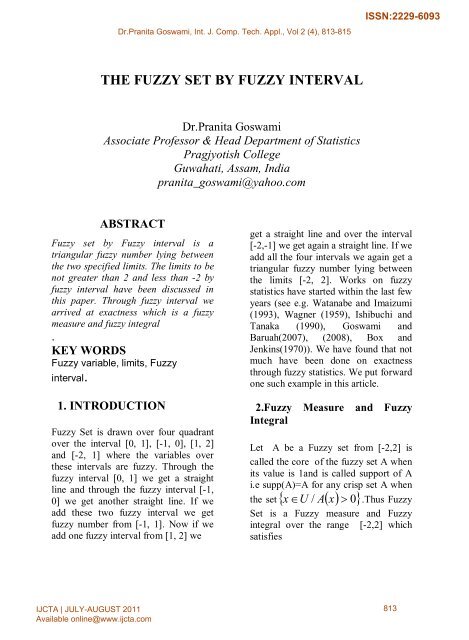FUZZY BINOMIAL DISTRIBUTION
FUZZY BINOMIAL DISTRIBUTION
FUZZY BINOMIAL DISTRIBUTION
You also want an ePaper? Increase the reach of your titles
YUMPU automatically turns print PDFs into web optimized ePapers that Google loves.
Dr.Pranita Goswami, Int. J. Comp. Tech. Appl., Vol 2 (4), 813-815<br />
ISSN:2229-6093<br />
THE <strong>FUZZY</strong> SET BY <strong>FUZZY</strong> INTERVAL<br />
Dr.Pranita Goswami<br />
Associate Professor & Head Department of Statistics<br />
Pragjyotish College<br />
Guwahati, Assam, India<br />
pranita_goswami@yahoo.com<br />
ABSTRACT<br />
Fuzzy set by Fuzzy interval is a<br />
triangular fuzzy number lying between<br />
the two specified limits. The limits to be<br />
not greater than 2 and less than -2 by<br />
fuzzy interval have been discussed in<br />
this paper. Through fuzzy interval we<br />
arrived at exactness which is a fuzzy<br />
measure and fuzzy integral<br />
.<br />
KEY WORDS<br />
Fuzzy variable, limits, Fuzzy<br />
interval.<br />
1. INTRODUCTION<br />
Fuzzy Set is drawn over four quadrant<br />
over the interval [0, 1], [-1, 0], [1, 2]<br />
and [-2, 1] where the variables over<br />
these intervals are fuzzy. Through the<br />
fuzzy interval [0, 1] we get a straight<br />
line and through the fuzzy interval [-1,<br />
0] we get another straight line. If we<br />
add these two fuzzy interval we get<br />
fuzzy number from [-1, 1]. Now if we<br />
add one fuzzy interval from [1, 2] we<br />
get a straight line and over the interval<br />
[-2,-1] we get again a straight line. If we<br />
add all the four intervals we again get a<br />
triangular fuzzy number lying between<br />
the limits [-2, 2]. Works on fuzzy<br />
statistics have started within the last few<br />
years (see e.g. Watanabe and Imaizumi<br />
(1993), Wagner (1959), Ishibuchi and<br />
Tanaka (1990), Goswami and<br />
Baruah(2007), (2008), Box and<br />
Jenkins(1970)). We have found that not<br />
much have been done on exactness<br />
through fuzzy statistics. We put forward<br />
one such example in this article.<br />
2.Fuzzy Measure and Fuzzy<br />
Integral<br />
Let A be a Fuzzy set from [-2,2] is<br />
called the core of the fuzzy set A when<br />
its value is 1and is called support of A<br />
i.e supp(A)=A for any crisp set A when<br />
the set { x ∈U<br />
/ A( x)<br />
> 0}<br />
.Thus Fuzzy<br />
Set is a Fuzzy measure and Fuzzy<br />
integral over the range [-2,2] which<br />
satisfies<br />
IJCTA | JULY-AUGUST 2011<br />
Available online@www.ijcta.com<br />
813
Dr.Pranita Goswami, Int. J. Comp. Tech. Appl., Vol 2 (4), 813-815<br />
ISSN:2229-6093<br />
(1) boundness :i.e g(-2)=0 and g(x)=1<br />
(2) monotonicity i.e A
Dr.Pranita Goswami, Int. J. Comp. Tech. Appl., Vol 2 (4), 813-815<br />
ISSN:2229-6093<br />
Pos<br />
F<br />
( A) Sup F( Y )<br />
=<br />
y∈A<br />
...<br />
(1)<br />
( A) = 1−<br />
Pos ( A) ...(2)<br />
and NecF<br />
F<br />
In our example the α cuts which are<br />
nested are<br />
A<br />
A<br />
1<br />
3<br />
U sin<br />
{ 0} , A2<br />
= { −1,<br />
0 1 },<br />
{ −1.5<br />
,1 ,1.5 }<br />
g(1)<br />
we find that Pos( A1<br />
)<br />
( A ) = Pos( A ) = 1<br />
=<br />
=<br />
Pos<br />
2<br />
andPos<br />
1/3, Pos<br />
( A1<br />
) = 2/3 , Pos( A2<br />
)<br />
( A ) = 0<br />
U sin g(2)<br />
we getNec(<br />
A ) = 1/3,<br />
Nec<br />
( A ) = 2/3, Nec( A ) = 1<br />
2<br />
3<br />
In this particular example by using<br />
uniform density function i.e from<br />
probability density function we have<br />
obtained possibility distribution<br />
function by using one probability<br />
measure over the same interval .<br />
1<br />
-2 0<br />
2<br />
Fuzzy set and Possibility<br />
distribution<br />
3<br />
3<br />
1<br />
=<br />
=<br />
0<br />
-1<br />
CONCLUSION<br />
Fuzzy set is drawn over<br />
constant density function i.e we have<br />
obtained possibility distribution from<br />
probability density function and the<br />
function remains in equilibrium about a<br />
constant mean level and converges<br />
where it is stationary. Thus we conclude<br />
that in this paper we arrive at exactness<br />
through fuzzy interval when it is linear<br />
which is Fuzzy Measure and Fuzzy<br />
Integral .<br />
REFERENCES:<br />
[1].G.E.P.Box and G.M.Jenkins. Time<br />
serier Analysis Holden day , San<br />
Francisco(1985),77-78<br />
[2].Goswami. P. and Baruah, H.K. The<br />
Fuzzy ARIMA(1,1)Process, The journal<br />
of Fuzzy Mathematics vol– 16.No.3,<br />
2008 Los Angeles<br />
[3].Goswami.P. and H.K.Baruah,<br />
Fuzzy time series analysis,J.Fuzzy<br />
Math ,Vol.15,Nos.3(2007),513-523<br />
[4].Ishibuchi, H and Tanaka, H. several<br />
formulations of interval regression<br />
analysis, proceedings of Sino–Japan<br />
Joint meeting on Fuzzy sets and<br />
systems, B2–2, (1990).<br />
[5].WagnerH.W.,Linear Programming<br />
techniques for regression analysis. J.<br />
Amer. Stats. Assoc., vol – 54 (1959)<br />
275 – 287.<br />
[6].Watanabe, N and Imaizumi, T. A<br />
fuzzy statistical test of fuzzy hypethesis.<br />
Fuzzy sets and systems 53 167–17<br />
North Holland (1993).<br />
[7].L.A.Zadeh,Fuzzy sets s a Basis for a<br />
Theory of Possibility .Int. J. of Fuzzy<br />
Sets and Systems ,Vol.1,(1978),3-8.<br />
IJCTA | JULY-AUGUST 2011<br />
Available online@www.ijcta.com<br />
815















